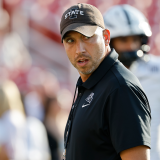How the staffs at Clemson, Ohio State and A&M get better
Gatherings like the one last week at OSU where the offensive staffs of Clemson, Ohio State and Texas A&M got together to trade ideas is just one of the ways teams get a little bit better in the offseason.

There really isn't much of an off-season for college football coaches these days. There's spring ball, preparation for spring ball, recruiting (which has essentially become a 365-days-a-year process), all sorts of meetings and their own personal skill development. The latter often means clinics, research and brain-storming sessions with peers.
Last week in Columbus, Ohio, there was quite a gathering of some of the brightest offensive minds in football at Ohio State. A bunch of guys with old Conference-USA connections, joked Buckeyes OC Tom Herman, a former Rice assistant, who helped host a two-day get-together.
The other old C-USA guys in attendance: Clemson OC Chad Morris, a former Tulsa OC, as well as Kevin Sumlin's Texas A&M staff of former Houston and Tulsa staffers. In all, you had the brainpower behind three of the top eight ranked offenses in college football last season (No. 3 Ohio State, No. 5 Texas A&M, and No. 8 Clemson). They all have pretty different systems but each has been wildly successful in their approaches.
"You're not trying to change the style of offense, you're just looking for a couple of little things where you can tweak your offense," says Texas A&M offensive coordinator Jake Spavital, a one-time Tulsa graduate assistant who recalled meeting Morris years ago when the Tiger OC was the Lake Travis (TX) high school head coach and would come visit then-TU offensive coordinator Gus Malzahn.
The Ohio State staff was able to get a better handle on Clemson's ability to use misdirection, and A&M's screen game and the myriad of ways the Aggies block it all up. The Buckeyes' guests gained insight into how Ohio State led the nation in rushing yards per carry with their command of the Power and the Counter.
For the Aggies, it was especially helpful to pick the brain of Morris and his Clemson staff for ways they can exploit the talents of agile 6-6, 274-pound Cam Clear. The Tigers, the A&M staff had observed from previous film study, had been adept at utilizing some of their big wideouts/tight end/H-back kind of weapons in a variety of ways from different formations.
"If you got a coaching a point out of it, you made the play better," says Spavital. "So you're talking, 'Maybe the QB needs to take a shorter drop, or maybe it's better if it's slower developing.'
"You're talking about timing issues (within the play) about what the path of the offensive linemen are; how the quarterback's footwork should be. There is a lot to be discussed and you kind of just chip away it.
"I know we got a lot of little things that made us better."
















